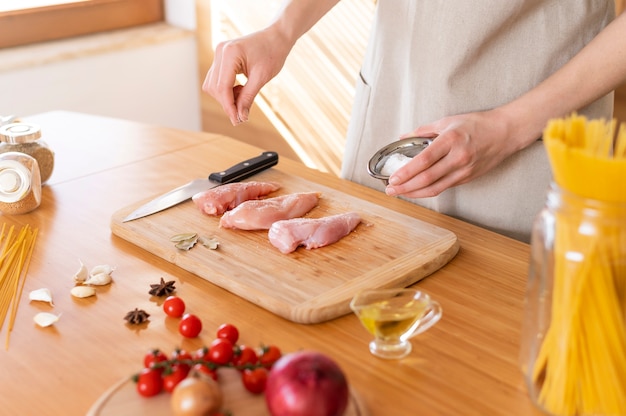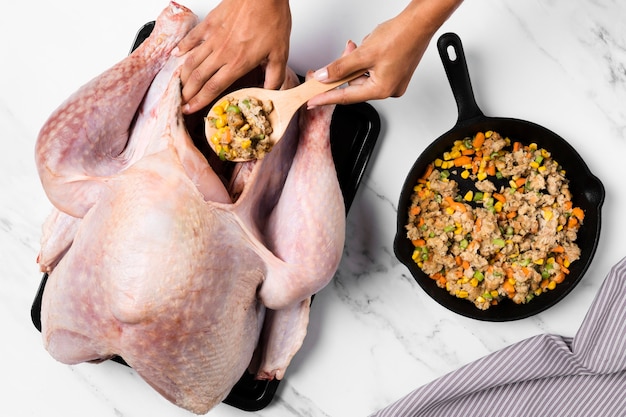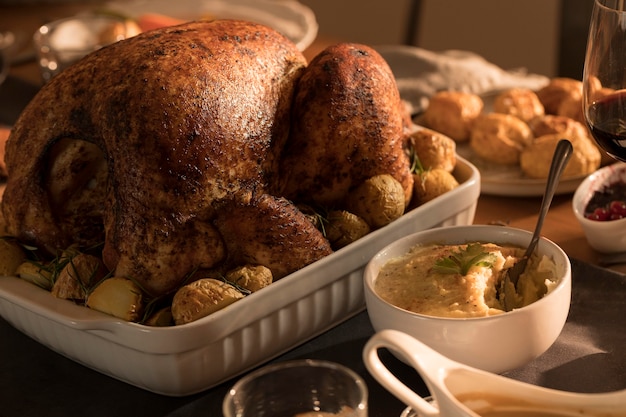Ah, roast chicken. The quintessential Sunday lunch, the comforting aroma that fills the house, the crispy skin that makes you sigh with contentment. I've been perfecting my roast chicken recipe for years, and I can honestly say, it's a skill that takes time and practice. There's a certain magic in getting that perfect balance of juicy meat and golden-brown skin. But the biggest question that always pops up is, "How long do I cook this darn thing?" Today, we're tackling the 5-pound bird – a great size for a family feast. Let's dive in and discover the secrets to a mouthwatering roast chicken.
Part 1: The Importance of the Right Bird

Let's start with the basics. You can't just grab any chicken from the supermarket and expect a perfect roast. You need a bird that's the right size and breed. I'm talking about a free-range chicken, preferably a whole bird, around 5 pounds. You can often find these labelled as "roasting chickens." Trust me, it makes a difference! You want a chicken that's got a little bit of fat under the skin, which contributes to the flavour and helps it stay juicy.
Why Free-Range?
I know, free-range chicken can be a bit pricier, but it's worth the extra pennies. The birds have more space to roam, eat a more varied diet, and that translates to a richer flavour. Imagine a chicken pecking around in a field, enjoying fresh grass and bugs, as opposed to a bird crammed into a tiny coop. It's a world of difference, and you'll taste it in your roast chicken. Plus, you're supporting more sustainable farming practices, which is always a good thing.
Choosing the Right Bird
When you're at the supermarket, look for a chicken that has a plump breast and drumsticks. Avoid any bird that seems dry or has a discolored skin. A good chicken should have a firm, springy breast and feel heavy for its size. Remember, you're investing in a delicious meal, so don't settle for anything less than the best!
Part 2: Getting Started: Preparing the Chicken

Now, let's get down to business. The first step is to prep the chicken. Don't be intimidated; it's actually quite straightforward. You'll need a sharp knife, a kitchen towel, and a few essential ingredients:
Essential Ingredients
- Salt (enough to generously season the chicken inside and out. I usually use about 1 tablespoon for a 5-pound bird)
- Freshly ground black pepper (you can’t go wrong with a good amount. I use a generous 1 teaspoon)
- Herbs (I like rosemary, thyme, and sage – it's a classic combination. For a 5-pound bird, I use about 2 tablespoons of herbs, chopped)
- Butter or olive oil (for a lovely crispy skin. About 2 tablespoons of butter is perfect)
Prep Steps:
1. Rinse the chicken: Rinse it thoroughly under cold water, inside and out, and pat it dry with a kitchen towel. 2. Seasoning: Liberally salt and pepper the inside and outside of the chicken, making sure to get under the skin. This is key for creating a flavorful and juicy bird. 3. Stuffing (Optional): If you like stuffing, this is the time to do it. I prefer a simple stuffing of bread, onions, and herbs. Don't overstuff the cavity. Leave some space for the chicken to cook evenly. 4. Tie the legs: Tuck the wings behind the back of the chicken and tie the legs together with kitchen twine. This helps the bird roast evenly and prevents the legs from drying out. You can use a piece of kitchen twine about 18 inches long and tie a double knot. 5. Pat it down again: Once you’ve stuffed and tied the chicken, pat it down again with a kitchen towel to remove any excess moisture. This helps the skin get nice and crispy.
Part 3: The Roast: Oven Time

Now we're getting to the fun part: roasting! But first, preheating the oven is crucial. You want it nice and hot.
Preheating:
Set your oven to 425°F (220°C). Why so hot? You want to create that initial sear, which helps get the skin crispy and the inside juicy. Once the oven is preheated, you can start roasting.
roasting time:
For a 5-pound bird, you’ll need to roast it for about 1 hour and 45 minutes. However, this is just a guideline. The best way to know if it’s done is to use a meat thermometer. Insert it into the thickest part of the thigh, not touching the bone. The chicken is cooked when it reaches an internal temperature of 165°F (74°C). If you don't have a thermometer, you can check if the juices run clear when you pierce the thigh with a fork.
Basting:
While the chicken is roasting, baste it with butter or oil every 30 minutes. This helps keep the skin moist and golden brown. I like to use a mixture of butter and herbs, but you can use whatever you prefer. Simply brush the butter or oil mixture over the chicken and the skin will start to get that beautiful golden-brown colour.
Resting:
Once the chicken is cooked, remove it from the oven and let it rest for 15 minutes before carving. This allows the juices to redistribute, ensuring the meat is juicy and tender. Cover the chicken loosely with foil while it rests, and the steam will help to keep the meat moist.
Part 4: Tips for a Perfect Roast
Over the years, I’ve picked up a few tricks that make my roast chicken even better. Here are a few tips to help you achieve that perfect roast:
Use a Roasting Rack:
A roasting rack elevates the chicken above the bottom of the pan, allowing air to circulate around it, resulting in even cooking and crispier skin. The heat from the oven will cook the chicken evenly, and the rack will prevent it from sitting in its own juices, which can make it soggy. You can find roasting racks at most kitchen stores or online.
Avoid Overcrowding:
If you’re roasting vegetables alongside the chicken, make sure they’re not too close to the bird. This can lead to uneven cooking and soggy vegetables. Space the vegetables around the chicken so that air can circulate and they cook evenly.
Don’t Overstuff the Cavity:
If you’re using stuffing, be sure not to overstuff the cavity, as this can trap moisture and prevent the chicken from cooking evenly. Leave some space for the stuffing to cook properly and prevent the chicken from becoming undercooked in the middle.
A Note About Temperatures:
If you're using a conventional oven, 425°F (220°C) is the ideal temperature for roasting a chicken. However, if you're using a fan-assisted oven, you might need to reduce the temperature slightly. Always check the oven manufacturer's instructions for specific recommendations.
Part 5: Serving Up Your Masterpiece
The moment of truth has arrived! After all that work, it's time to carve up your masterpiece. I like to serve my roast chicken with a side of roasted vegetables (potatoes, carrots, and onions are classic choices) and a rich gravy. For the gravy, I simply deglaze the roasting pan with wine or broth, then thicken it with flour.
Carving:
Carve the chicken carefully, using a sharp knife to remove the breasts, legs, and thighs. Don’t forget the crispy skin! It's the best part. Start by removing the legs and thighs. Then, use a fork to gently lift the breast away from the bone and slice it into thin pieces. Remember, the crispy skin is a prized part of the roast chicken, so don't discard it!
Presentation:
Arrange the carved chicken on a platter, with the vegetables and gravy alongside. For a touch of elegance, I like to garnish the platter with fresh herbs. A sprig of rosemary or a few thyme sprigs add a nice visual touch.
Part 6: The Leftovers: No Waste, Just More Deliciousness
Let's face it, sometimes there are leftovers. But don't despair! Roast chicken leftovers are the best. You can use them for sandwiches, salads, soups, or even a second round of roast chicken dinner.
Cold Chicken:
Cold roast chicken is delicious in sandwiches, salads, or simply enjoyed with a side of pickles or mustard. You can even make a chicken salad sandwich by combining shredded chicken with mayonnaise, celery, and onion.
Chicken Soup:
The bones from the roast chicken can be used to make a hearty and flavorful soup. Simply simmer them in water with vegetables and spices for a few hours. The bones will release their flavour and collagen, creating a rich and nourishing broth.
Chicken Pot Pie:
Use the leftover chicken, along with vegetables and gravy, to create a comforting pot pie. You can use a store-bought pie crust or make your own. Add some peas, carrots, and potatoes to the filling for a hearty and flavorful dish.
Chicken Curry:
For a change of pace, try using the leftover chicken in a curry. Add some chopped onions, garlic, ginger, and spices to a pan and cook until fragrant. Then add the chicken, tomatoes, and coconut milk. Simmer until the chicken is cooked through and the sauce is thickened.
Part 7: Roasting a 5-Pound Chicken: A Table
To make it easy for you to keep track of the roasting time for a 5-pound chicken, here’s a handy table:
| Step | Time |
|---|---|
| Preheat Oven | 10-15 minutes |
| Roast Chicken | 1 hour 45 minutes |
| Rest Chicken | 15 minutes |
Part 8: FAQs About Roasting Chicken
Let's address those lingering questions you might have about roasting chicken. Here are some common FAQs:
1. Can I roast a chicken at a lower temperature?
Absolutely! You can roast a chicken at a lower temperature, like 350°F (175°C), but it will take longer to cook. The rule of thumb is to add about 30 minutes to the roasting time for every 25°F decrease in temperature. For example, if you roast a chicken at 350°F, it will take about 2 hours and 15 minutes. Lower temperatures can be good for a more tender and juicy breast, but the skin won't get as crispy.
2. Can I use a rotisserie to roast my chicken?
Yes, using a rotisserie is a great way to roast chicken. It helps to ensure even cooking and creates that delicious crispy skin. If you have a rotisserie oven, it's definitely worth using it for your roast chicken. The chicken will be cooked evenly on all sides and the skin will be beautifully crisp.
3. How do I know if the chicken is fully cooked?
The best way to know if the chicken is cooked through is to use a meat thermometer. Insert it into the thickest part of the thigh, not touching the bone, and make sure it reaches an internal temperature of 165°F (74°C). You can also check by gently pressing the meat; it should feel firm to the touch. If the juices run clear when you pierce the thigh with a fork, that's another indication that it's cooked through.
4. What if the skin isn't crispy?
If the skin isn’t crispy, you can try putting the chicken under the broiler for a few minutes to help it brown. Just be careful not to burn it! Keep a close eye on the chicken under the broiler, as it can brown very quickly.
5. What are some creative ways to flavor the chicken?
Get creative! You can use a variety of herbs and spices to flavor your chicken. Some popular options include: garlic, onion, paprika, lemon, or even a touch of chili powder. You can also use citrus fruits like lemons or oranges. Try rubbing the chicken with a mixture of herbs and spices before roasting for a flavorful result. You can also use a marinade for a more intense flavour.
Part 9: A Final Thought: The Joy of Roasting
So there you have it, the complete guide to roasting a 5-pound chicken. It might seem like a lot of steps, but trust me, it’s worth the effort. There’s something incredibly satisfying about creating a delicious and comforting meal from scratch. The aroma of roasted chicken filling your home, the golden-brown skin that crackles when you carve it, the juicy meat that melts in your mouth – these are the moments that make cooking a true joy.
Enjoy the process, experiment with different flavours, and most importantly, savor the delicious results! Happy roasting!
Everyone is watching

Corn on the Cob: The Ultimate Guide to Perfectly Cooked Ears
Healthy MealsAh, corn on the cob. Just the name evokes images of sunny days, barbecues, and that sweet, juicy flavour that ...

Perfect Pork Roast Oven Cooking Time: A Guide to Delicious Results
Healthy MealsThere's something truly satisfying about a perfectly roasted pork. The aroma alone is enough to make your mout...

Ham Cooking Time: How Long to Bake, Smoke, or Boil a Delicious Ham
Healthy MealsAh, ham. It's a classic, isn't it? A real crowd-pleaser, especially around holidays. And when done right, it'...

Scallops: The Ultimate Guide to Perfect Cooking
Healthy MealsAh, scallops. Those delicate, sweet, and utterly delicious morsels of the sea. They hold a special place in my...

Spaghetti Squash: The Ultimate Guide to Cooking and Serving
Healthy MealsRemember that time you saw spaghetti squash at the supermarket, looking all bumpy and strange, and thought, "W...
